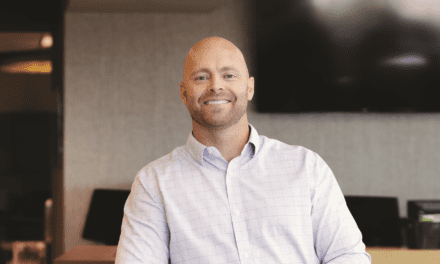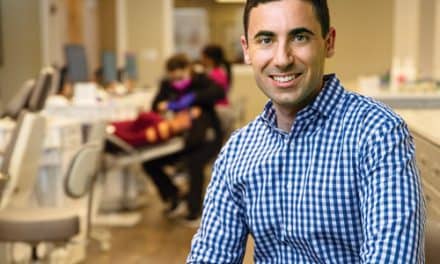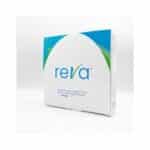by Rich Smith
Feldman Orthodontics runs on the power of family
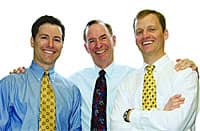
Good thing Barry Feldman, DDS, doesn’t listen to most business advisers. In the late 1990s, he opened the door of his modest Cheshire, Conn, practice to a pair of young orthodontists and, today, things have never been better.
The newcomers are Feldman’s own sons: Jonathan (Jonny) Feldman, DMD, MS, and David Feldman, DMD. Jonny joined the practice in 1997, straight out of his orthodontic residency at the University of North Carolina, Chapel Hill. Older brother David signed on in 1998, immediately after completing his orthodontic training at State University of New York, Stony Brook.
It was but a few years later that Jonny and David were each drawing the same salary as their father. “We started splitting the pot three equal ways in 2002, and have done so on a consistent basis since then,” says Barry, who practices under the name Feldman Orthodontics. “In all that time, my own salary never once has decreased.”
A Youth Movement
Bringing aboard Jonny and David did not imperil the practice financially because their presence served only to strengthen Feldman Orthodontics’ position in the market, which translated into a brisk rise in practice revenue. “We brought with us fresh ideas and new technologies that helped us deliver even better results to patients and, at the same time, kept our overhead in check,” David says.
|
||||||||||||||||||
More than that, David and Jonny—board certified in orthodontics like their father—made a point of becoming actively involved in the community as soon as they joined the practice. Says Barry, “They were very successful at developing their referral base using that approach.”
And one more thing. David and Jonny’s relative youth caused teenagers to gravitate to the practice in numbers Barry hadn’t seen in years. “Youth feels a connection to youth, even though in this situation David and Jonny were grown men,” he says. “But, being the ages they were, David and Jonny had no trouble being conversant with young patients when it came to sports, music, movies, fashions, and fads. You could just see it on the faces of the patients—how they loved being here for that reason.”
Not long after the brothers came into the practice, they proposed setting up a satellite office in the nearby town of Wallingford, Conn, to provide additional income opportunities. That office still has a way to go before it catches up with the Cheshire flagship in terms of production. Cheshire is currently about 30% busier, mainly because Cheshire is longer established (it opened in 1971) and benefits from a long-standing referral pattern.
On Time, All the Time
The two offices are each about 1,450 square feet, and both are located in medical office buildings. (Barry is a majority shareholder in the building that houses the Cheshire office; the family rents the space it uses in Wallingford.) Beyond being virtually identical in size, the offices also closely mirror each other with regard to layout. “We have completely open-bay, four-chair operatories—and a fifth chair in what doubles as the records room,” Barry says. “We prefer open-bay because it relieves the anxiety kids feel in an orthodontist’s chair if they can see other children in the room with them.”
As to motif, the Feldmans have chosen to go with a simple, clean, clinical presentation at both locations. One of the few nods to personality over functionality is a wall of faces: photos of hundreds of former patients and their brand-new, beautiful smiles. Scattered here and there among the photos are posters of sports teams and individual players beloved by the Feldmans (who, by the way, are huge fans of the New York Mets and Giants). Also adorning the walls are paintings by Barry’s mother-in-law and dramatic photographs snapped by shutterbug hobbyists Barry and David.
Handheld video games are available to waiting patients. “We like the idea of giving kids something to play with before we get them into the chair, but we didn’t want to set up bigger arcade-style game systems,” Barry says. “We felt those would detract from the professionalism we want to project. Likewise, continuous-play movies on video monitors—we don’t have those either for that same reason.”
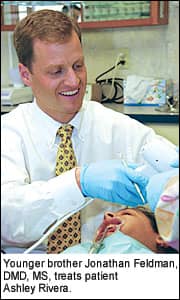
The management system also allows for automated sign-in of patients—accomplished in the Feldman Orthodontic offices by means of biometric-recognition software. Says Barry, “The patient comes in and presses a finger to the scanner, which then reads the fingerprint and matches it to the fingerprint we have on file of that patient. It takes maybe a second or two to make the match. Then, the system asks the patient to confirm that the name it puts up on the screen is his or hers. The patient presses ‘yes,’ and the system then proceeds to pull up the correct chart for our use at chairside.” The system also tracks how much time it takes to get the patient into the chair after his or her arrival and how much time it takes to perform each task while he or she is in the chair, so that the Feldmans can later discern workflow patterns that may need to be refined to speed things up.
Cool and New Meet Tried and True
Despite Barry Feldman’s ready embrace of office technology, he confesses to not being an early adopter of clinical innovation.
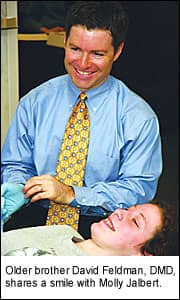
By the same token, neither does Barry relish being branded a latecomer. “It’s a fine line I try to walk. I like being as cutting-edge as possible, because that’s good for my patients and ultimately good for my practice’s growth prospects. But I don’t want to be too cutting-edge, because I feel I have an obligation to provide care that is evidence-based.”
A favorite of Barry’s for which there is a great deal of positive evidence is the Begg technique, in which teeth are moved by tipping the crowns rather than moving them laterally. It is an older technique, but Barry says he prefers it because it minimizes the use of orthodontic force.
“I grew up in this profession as a wire bender, but, even so, I’m now doing more straightwire technique, which I’ve picked up from my sons,” he says. “Straightwire is the technique they grew up with. Yet there are times when the Begg technique is the better way to go. In those instances, because Begg isn’t to them second nature as it is to me, I’ll step in and be the one to do that work.”
The Cheshire Grin
In strict terms, Barry did not actually grow up as a wire bender. He grew up as a New Yorker—a Brooklynite, to be precise.
Blessed with an aptitude for math and science, young Barry enrolled at Colgate University, Hamilton, NY, in 1958 as a premed/predental student. In his third year, he announced his decision to become a dentist, following in the footsteps of his dentist father and maternal uncle (and, technically, his hygienist mother).
“My dad thought I’d be better off as a physician, but I saw how, as a dentist, he was more in control of his life than any physician I’d ever known. He was able to keep regular hours and take real vacations—seven weeks once for a cross-country car trip with the family, and usually twice a year to take us all skiing in the mountains. You generally can’t enjoy that sort of lifestyle as a physician, especially if you’re a physician connected to a hospital.”
In 1961, Barry entered Columbia University School of Dentistry, completing the program in 1965. Just prior to his final year at Columbia, his uncle, who practiced in New London, Conn, invited Barry to spend spring break with him. During those 2 weeks, Barry toured the offices of many of his uncle’s dental colleagues around town. “My uncle, Alec Shapiro [DDS, father of Peter Shapiro, DDS, now a Seattle orthodontist and formerly chairman of the orthodontics department of the University of Washington] arranged for me to spend 2 or 3 days apiece in the practice of an oral surgeon, a periodontist, an endodontist, and an orthodontist,” he says. “My uncle felt I would gain from this exposure a strong sense of what each of these subspecialties was really all about, to help me make a better decision about the direction I should take after dental school.”
Barry came away from that private mini-rotation convinced that orthodontics was the way to go. “I liked the idea of working with children, not having to hurt anybody while in the chair, and having patients be genuinely thrilled with the results at the end of treatment,” he says. “I mean, you can carve the most beautiful filling in the world, but the gratification just isn’t the same as when you take off a set of braces.”
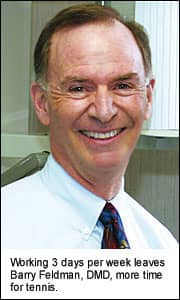
Following a short stint as chief of dental services at a mental health institution, Barry was accepted to Columbia University for orthodontic training. In 1970, he completed the program and entered practice as an associate with an established orthodontist in New Haven, Conn. Barry and the orthodontist enjoyed a good working relationship, but, alas, there was no hope of it blossoming into a formal partnership. Barry then struck off on his own. After shopping around, he settled on the town of Cheshire as the ideal home for his new solo practice. “Cheshire was one of the state’s fastest-growing towns, but it had only a part-time orthodontist. I sought to become its first full-time orthodontist,” he says.
In Their Father’s Footsteps
Like Barry, David and Jonny both attended Colgate University (David was class of 1989; Jonny was class of 1990), but their reasons for picking that school had little to do with it being their father’s alma mater. For David, the lure was a great academic program; for Jonny, it was that plus the athletics.
“Dad didn’t push us to go to Colgate,” David says. “He didn’t push us into anything, not even dentistry. He gave us the freedom to make our own choices—and by letting the example of his life silently guide us, we ended up making choices similar to those he himself made. Right choices, we’re convinced.”
After Colgate, David found work as an investment banker in New York City. In 1991, with a recession raging, he left the world of finance and entered dental school at the University of Connecticut—as did Jonny, who completed that program in 1994, a year ahead of David, having entered directly from Colgate.
From there, the brothers went to different schools for orthodontic training. When it came time to plan for entry to practice, neither had any thought other than to return home and add their names to the marquee on the doorpost of Feldman Orthodontics. “Choosing to work alongside Dad was a no-brainer,” Jonny insists. “Connecticut was where our family and friends were; David and I couldn’t think of a better place to be in practice. Besides, as a family in practice together, we knew we would have advantages that would be hard to duplicate in a solo setting or with relative strangers in a group. For example, we know how to really play off one another’s strengths because of having lived together as a family. The result of that has been a remarkably collegial, smooth-running practice.”
David agrees. “I love working with Dad and Jonny. It feels really good. No big negatives about it at all.”
Work is a sizable part of the brothers’ lives, but not the only part. In addition to his practice responsibilities, Jonny teaches 1 day per week at the University of Connecticut in the school’s orthodontic program. He also teaches at St Raphael’s Hospital in that New Haven institution’s surgical program. (David teaches there as well.) And the brothers are each raising families of their own. Jonny is married to local obstetrician-gynecologist Debbie Feldman, MD; they have two daughters, Allison, 8, and Sarah, 6. David’s wife is Wendy Becker, DMD, a general dentist in a Wallingford group practice; they have two sons, Jonah, 4, and Ryan, 3.
Work Hard, Play Harder
One hundred years ago, when it was very common for sons to work alongside their fathers, the generations seemed naturally more close-knit. That’s the way it is for the Feldmans, although it must be said that Barry, David, and Jonny enjoyed a special, deep bond long before they became practice partners.
Much of that bond has been built around skiing, the family’s favorite sport. But golf also excites them. (Barry contends his game is a tad better than either David’s or Jonny’s because he works in the office fewer days and doesn’t have young children to raise, so he has more time to practice.) Separately, Barry is a tennis buff, David plays hockey and softball, and Jonny is a marathon runner. “We’re all a very athletic group, and we love to compete against one another in the sports we participate in as a family. I’ve got a ping-pong table at my house, and we still battle it out every time we get together there,” Barry says with a laugh.
Barry’s athleticism is enviable, considering he recently turned 65. And, now that he is at retirement age, Barry is beginning to think about easing out of the clinical picture. “I’ll still be active in the practice for some years to come, but my primary focus may eventually become the business side of it,” he reveals. “I’ve always done the financials myself; that won’t be anything new for me. The only thing that really will be different is I might slow down to two or maybe one day a week being in the office. Basically, I want to be here until the day David and Jonny tell me it’s time to officially retire. But even at that, I’ll continue living here in Cheshire. No moving to Florida for me and being apart from my family.”
After all, it was a desire to not be separated that led Barry to set out the welcome mat for the two fine young orthodontists who wanted to join him in practice almost a decade ago—a decision neither he nor they has regretted.
Rich Smith is a contributing writer for Orthodontic Products.




